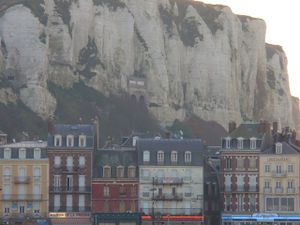Normandy
Normandy [1] (French: Normandie) is an area of northern France, bordering the English Channel. Normandy is famed for the D-Day Allied invasion on June 6, 1944. Regions[edit]The region was formerly divided into two administrative areas: These have since been merged to form the Normandy region on 1 January 2016. Cities[edit]
Other destinations[edit]
Understand[edit]Talk[edit]Get in[edit]By car[edit]From Paris Take the A14 north out of Paris towards Rouen for around 20 km, then take the A13 towards Le Havre and Caen. The A13 will take you to the Caen ring road (périphérique). Caen can be a useful base to explore the region. By train[edit]Trains leave Paris from Gare Saint-Lazare to Rouen, Caen, Lisieux and Cherbourg. You can catch trains from these places to other destinations such as Deauville, Valognes, Carentan or Bayeux. By ferry[edit]Brittany Ferries [2] to Ouistréham, near Caen, from Portsmouth, and to Cherbourg from Portsmouth and Poole. LD Lines to Le Havre from Portsmouth, and to Dieppe from Newhaven. Travellers from London and South East England may find it quicker and more flexible to use the shorter, and more frequent, ferry services [3], or the Channel Tunnel to Calais, and then drive to Normandy on the good motorway routes across Northern France. Get around[edit]A (mostly) coastal footpath (the 'GR223') goes all the way from Honfleur on the east to Avranches and then to Mont Saint Michel, on the Brittany border on the west. You can choose to go the whole way if you can walk for a month ! Otherwise select day trips or 2-3 days trips in the most interesting parts: History fans will choose the D-Day beaches, while lovers of spectacular nature (cliffs and coves) will walk around la Cap de la Hague, west of Cherbourg, or choose to walk to Mont Saint Michel. Discover the Alabaster Coast: Lined up along the Normandy steep coast with its spectacular chalk cliffs, a number of scenic villages invites visitors to explore, discover and enjoy their surroundings: the beaches of Pourville (treat yourself to a serving of excellent oysters!) and Quiberville, Varengeville with its old church perched high up on a rock and its enchanting park «Bois de Moutier«, in Veules les Roses the ancient water mills on France's tiniest river, the Benedictine monastery of Fécamp — or take a walk across the beach to admire the famous chalky pinnacles and arches of Etretat. And don't forget to visit some of the numerous antiquities shops that are known to have surprised many browsers with unexpected finds! In the hinterland there are a lot of beautiful places to discover, for instance the Sâane valley with its moated castle of Imbleville, or the Château de Miromesnil, birthplace of novelist Guy de Maupassant.
See[edit]Le Tréport near Dieppe The Normandy Coasts: The white cliffs of the Alabaster Coast in Etretat, the posh resorts of the Cote Fleurie, Deauville, Trouville, Cabourg, Houlgate, and the old city of Honfleur, the beaches of the Cote de Nacre, the D-Day landing beaches of Omaha Beach, Utah Beach (American andings), Sword Beach, [Gold Beach (British landings), and Juno Beach (Canadian landing), the Cotentin Peninsula, with the lively harbors of Barfleur and St-Vaast in the Val de Saire, and the wild and rugged landscapes around La Hague, and the long stretch of sandy beaches that lead south to the Mont-St-Michel. Do[edit]
Buy[edit]Eat[edit]Norman cuisine is based around the three main products of the region: seafood, apples and dairy products. Specialities from the sea include Dieppe sole and Normandy oysters. Normandy is the home of several world-famous cheeses: Neufchâtel, Pont-L'Evêque, Livarot (also known as the "Colonel"), and the round Camembert of Marie Harel. Normandy is renowned for its variety of meats, from the delicate flavor of saltmarsh lamb to creamy chicken "à la Vallée d'Auge" and duck "à la Rouennaise". The creamy omelettes of the Mont Saint Michel, the Vire andouille sausages, tripes cooked "à la mode de Caen", the "boudin" sausages of Mortagne, and the recent introduction to the region of foie gras, are also guaranteed to satisfy the most demanding gastronome. Local desserts include "bourdelots" or "teurgoule", or such sweets as Isigny toffees or apple sugars from Rouen. Drink[edit]Apples being a major item of produce in the orchards of Normandy, it is not surprising that cider - still or sparkling, dry or sweet, or perry - is a favorite regional tipple. Also derived from Norman apples is the famous calvados apple brandy (the trou normand). Produced and originating in the region (from the abbey at Fécamp on the coast) is the famous Bénédictine liqueur. Sleep[edit]Stay safe[edit]Weather in Normandy can be unpredictable but is often very nice. One of the best seasons to visit Normandy is September. Get out[edit]WikiPedia:Normandy World66:europe/france/normandybrittany
|
|









